Entries from March 2009 ↓
March 31st, 2009 — Hip-Hop, Photography
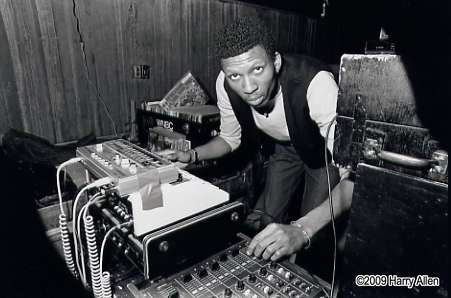
Before I started writing professionally, I took pictures of the stuff I was doing and people with whom I was mostly hanging out, the members of Long Island’s Spectrum City mobile d.j. crew. After I became a writer, I stopped shooting to a great extent, put my negatives in bags, congratulated myself on accumulating the world’s largest archive of Spectrum pics, and called it a day.
Subsequently, Spectrum reinvented themselves as the hip-hop crew Public Enemy. Much to my delight, people started asking to see those pictures.
Someone else just did. At 7:30 pm, tomorrow night, Wednesday, April 1, at the University of Iowa’s Iowa Memorial Union, I’ll be speaking as part of the University of Iowa Lecture Series.
For more than 30 years, The University of Iowa Lecture Committee has brought some of the world’s great thinkers to the University of Iowa campus. Speakers have included an impressive roster of national and international figures in science, politics, business, human rights, law, and the arts. Each year the University hosts from 6 to 10 thought-provoking lectures. These events help enrich Iowa’s academic environment and enhance its reputation as a prestigious Big Ten university.
My lecture is titled “Part of the Permanent Record,” and takes its name from the Eyejammie Fine Arts Gallery exhibition of my work in the summer of 2007. Wednesday night, I’ll be screening some of those photographs and talking about the journey through hip-hop I’ve been blessed to make with Chuck D, Flavor-Flav, Bomb Squad leader Hank Shocklee, above, and the rest. (An article in the local Corridor Buzz, previewing the lecture, goes into a lot of that.) I’m really honored to have this opportunity, and I’m looking forward to the talk. If you’re in Iowa, come through. Admission is free.
March 30th, 2009 — Art, Medicine, Photography, Science

Most third-year students of medicine at Weill Cornell Medical College use a Computed Axial Tomography scanner for medical purposes. But for Satre Stuelke, the technology works best as a new form of camera. By running children’s toys, cell phones, and electrical appliances through this advanced scientific tool, Stuelke produces rather unearthly images, of a kind perhaps never before seen. Radiology Art, he calls it.
Continue reading →
March 27th, 2009 — Books, NONFICTION, Technology

What do you see when you look at this picture?
Most would say they see a tranquil fall scene, perhaps somewhere in New England, and an empty road beckoning them to great times and even better memories. Of course, they’d be correct.
Few would say that they’re looking at an interface. When most people think of that word, they think of the stuff that you’re probably dealing with right now–clicking computer mouses, dragging cursors, scrolling bars, keyboards, the screen, etc.–all of which are tools that let you get to the motherboard, hard drive, CPU, and data that is “really” your computer.
 But an interface is precisely what you’re seeing in the image. In fact, you’re seeing at least two: the forest, and then the road. Even more, depending on how you see the forest, and what you notice when you do, right, one could argue that you’re looking at, not just one but, a series of complex independent interfaces–ones that, together, we read as “nature”–all of them enabling access to a host of subsystems that trap moisture, scrub air, regulate and capture sunlight, house animals, fertilize soil, stabilize ambient temperature, ablate wind, feed users, etc., etc. Indeed, nature is continuously “computing.” It’s just so low-key about it that not only do we not notice, we don’t even think of it this way. (Plus, nature never crashes.)
But an interface is precisely what you’re seeing in the image. In fact, you’re seeing at least two: the forest, and then the road. Even more, depending on how you see the forest, and what you notice when you do, right, one could argue that you’re looking at, not just one but, a series of complex independent interfaces–ones that, together, we read as “nature”–all of them enabling access to a host of subsystems that trap moisture, scrub air, regulate and capture sunlight, house animals, fertilize soil, stabilize ambient temperature, ablate wind, feed users, etc., etc. Indeed, nature is continuously “computing.” It’s just so low-key about it that not only do we not notice, we don’t even think of it this way. (Plus, nature never crashes.)
What would it take to create hardware and software that do what nature’s do: Vanish, so that you don’t even perceive them any more?
In his book, Everyware: The Dawning Age of Ubiquitous Computing, author Adam Greenfield argues for a nearing era of “ubiquitous computing…a computing without computers, where information processing has diffused into everyday life, and virtually disappeared from view.”
 Like Martin Luther, right, who wrought a revolution when he nailed his 95 theses to the door of the castle church in Wittenberg, Greenfield has divided his text into 81 “‘theses on the next computing,’ divided into six sections.” As he says in the intro to his book,
Like Martin Luther, right, who wrought a revolution when he nailed his 95 theses to the door of the castle church in Wittenberg, Greenfield has divided his text into 81 “‘theses on the next computing,’ divided into six sections.” As he says in the intro to his book,
This book is an attempt to describe the form computing will take in the next few years. Specifically, it’s about a vision of processing power so distributed throughout the environment that computers per se effectively disappear. It’s about the enormous consequences this disappearance has for the kinds of tasks computers are applied to, for the way we use them, and for what we understand them to be.
Although aspects of this vision have been called a variety of names – ubiquitous computing, pervasive computing, physical computing, tangible media, and so on – I think of each as a facet of one coherent paradigm of interaction that I call everyware.
How possible is this, or likely? Even more, what will it mean for human culture when our computers become so powerful that they just blend into the woodwork, so to speak?
Adam Greenfield is the guest today on this repeat edition of my WBAI-NY / 99.5 FM radio show, NONFICTION, this afternoon, Friday, March 27, at 2 pm ET.
You can hear his ideas by tuning in at 2 pm. If you’re outside of the New York tri-state, check out our stream on the web. If you miss the live show, dig into our archives for up to 90 days after broadcast.
March 26th, 2009 — Hip-Hop, Media, Music, Technology
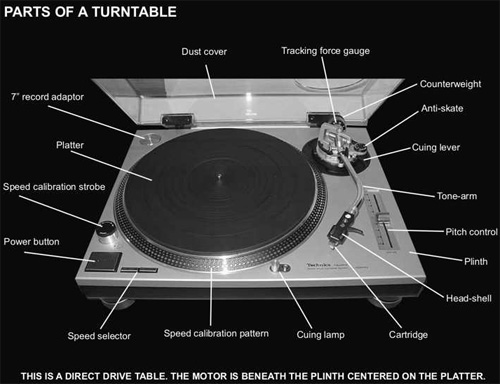
Why did hip-hop succeed?
That’s probably the first question I’m going to be asking tonight at the free Future of Music 4: The Rise of Hip Hop and its Influence on Other Media panel, 8:30 pm, at Tekserve (119 W. 23rd St., bet. 6th & 7th Aves.; 212-929-3645), New York City’s premier Apple retail and repair store. My job is moderating a discussion between DMC, aka Darryl McDaniels of Run-DMC fame; the pugilistic Freddie Foxxx, aka Bumpy Knuckles; and Troy Hightower, of Hightower Productions, the renowned audio engineering firm. I’m expecting a rich convo from this power-packed trio.
 Some background about “Future of Music”: We’ve been hosting these events at Tekserve, right, more or less bimonthly, as of this year. The turnout’s been consistently excellent, and I’ve been having a fantastic time with the folks there. Tekserve’s a great shop to roll through, ask questions, or just see the latest toys. It’s a friendly, helpful kind of establishment, of the sort that you don’t see a lot anymore, especially around anything having to do with computers. Hey: I’m not just president of the panels we do: I’m a client. In fact, every post I’ve ever written for MEDIA ASSASSIN, including this one, was created with a PowerBook G4 12″ that I bought at Tekserve four years ago, and it’s still clicking along. Consider me one of the faithful, as I expect we’re gonna meet, and make, more tonight.
Some background about “Future of Music”: We’ve been hosting these events at Tekserve, right, more or less bimonthly, as of this year. The turnout’s been consistently excellent, and I’ve been having a fantastic time with the folks there. Tekserve’s a great shop to roll through, ask questions, or just see the latest toys. It’s a friendly, helpful kind of establishment, of the sort that you don’t see a lot anymore, especially around anything having to do with computers. Hey: I’m not just president of the panels we do: I’m a client. In fact, every post I’ve ever written for MEDIA ASSASSIN, including this one, was created with a PowerBook G4 12″ that I bought at Tekserve four years ago, and it’s still clicking along. Consider me one of the faithful, as I expect we’re gonna meet, and make, more tonight.
So, first I’ll talk with the panel: What is the source of hip-hop’s influence? How has it affected the media we consume? Where do we see the greatest resistance to its clout, and what is at risk where it is denied? Then we’ll take questions from you, our always-curious audience. The issues are serious, the talent is legendary, and you rarely get to just ask these guys questions, so represent.
March 25th, 2009 — Books, Politics, Race
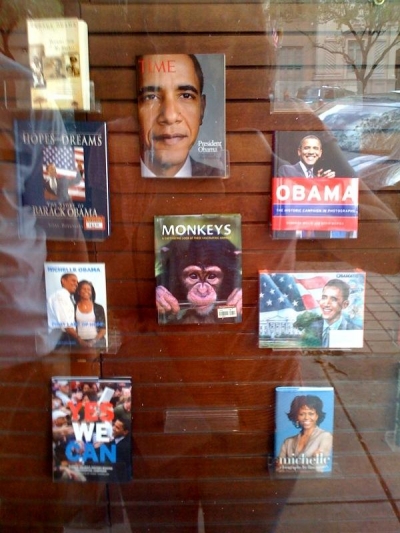
You’re looking at a photo, above, of a Coral Gables, FL Barnes & Noble window display of current books about Barack and Michelle Obama, their family, and President Obama’s historic run for the White House.
Dead center, as you’ve cerainly noticed, is a book titled Monkeys.
Continue reading →
March 24th, 2009 — Design, Government, Money

“A million here, a million there….”—Lil Wayne, “A Milli”
“Let’s make it a billion….”—Jay-Z, “A Billi,” feat. Lil’ Wayne
“A billion here, a billion there, and pretty soon you’re talking real money.”—attributed to late U.S. Senator Everett Dirksen (R-IL)
 For the first time in U.S. history, it is not uncommon to hear politicians talk about trillions of dollars when discussing sums relevant to our national budget. For example, just yesterday, the Obama administration announced that, working with private institutions, the government would acquire over $1 trillion worth of toxic mortgage securities. The U.S. deficit is expected to hit $1.8 trillion this year. The price tag of the Iraq War has been estimated at $3 trillion. Over the next decade, President Obama’s deficits, the Congressional Budget Office has estimated, could total $9.3 trillion.
For the first time in U.S. history, it is not uncommon to hear politicians talk about trillions of dollars when discussing sums relevant to our national budget. For example, just yesterday, the Obama administration announced that, working with private institutions, the government would acquire over $1 trillion worth of toxic mortgage securities. The U.S. deficit is expected to hit $1.8 trillion this year. The price tag of the Iraq War has been estimated at $3 trillion. Over the next decade, President Obama’s deficits, the Congressional Budget Office has estimated, could total $9.3 trillion.
Most people have no idea whatsoever how much money these words represent, though. Some understand the basic math: A thousand dollars equals ten $100 bills, like the crisp note, above. A million bucks is a thousand bundles of a thousand dollars. (O.K., it’s starting to get fuzzy already….) A billion is a thousand millions. A trillion is a thousand billions.
But even these words do little to convey the size of the funds under consideration. I mean, even the best description I ever heard of how big a trillion dollars is—more than it’d cost to spend a million dollars every day since the birth of Christ—doesn’t really convey it. How long ago was Christ born? How big is a million? What does it feel like to live, let alone spend money, for centuries?
A picture, however, is still truly worth a thousand words, and the creator of the PageTutor article, “What does one TRILLION dollars look like?”, has literally performed a national service, answering that question in a way, I promise, you will never, ever forget.
He starts with a $100 bill, like the Benjamin, below.

Pretty much anyone who works can relate to this piece of currency. It neatly fits into our common spending and earning protocols. It is the largest U.S. bill being circulated.
Next, “A packet of one hundred $100 bills is less than 1/2″ thick and contains $10,000. Fits in your pocket easily and is more than enough for week or two of shamefully decadent fun.”

Next, here’s what a million dollars in those $100 bills looks like, next to a white guy for both scale and relevance:

Now, feast your eyes on $100 million, set square upon a pallet.

You’d need more than seven of these to pay for one day of U.S. operations in Iraq.
A billion dollars has effectively been the common unit of spending for government purposes at least since the 1960s. As noted, above, Senator Dirksen is famed to have said as much in his “A billion here…there” quip.
Here’s what a billion dollars looks like at this scale, on ten $100 million pallets.

And finally, a trillion dollars, the new unit of government spending, after the jump:
Continue reading →
March 23rd, 2009 — Advertising, Fashion, History, Media, Race
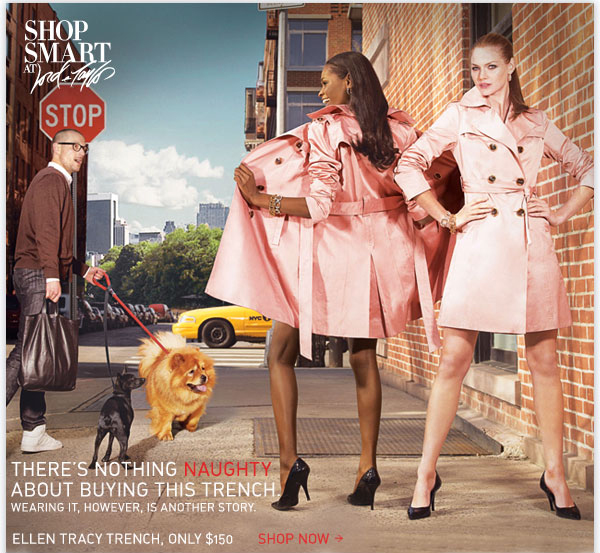
So wrote Leroy Colson of Detroit MI this past Friday, in an e-mail to MEDIA ASSASSIN. The Lord and Taylor ad to which he refers, above, shows two models wearing pink, $150 Ellen Tracy trench coats.
Well, rather, one of them—the white one facing the camera—wears the coat. The other one—the Black one with her back to you—can’t help flashing a white man walking by with two dogs, both of which, if you look closely, have their eyes punningly trained on her putty-tat. The auburn-colored chow is even tugging like he’s gonna run after it.
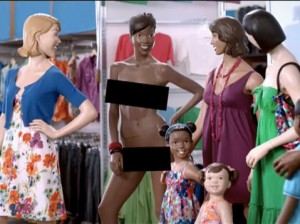 Colson tipped me to this image after he read this past Thursday’s post, “Are There Racists at Old Navy, or Do They Think That We’re Dummies?” That piece described what I perceived as the underlying racial code of the current Old Navy “Mid-Town Flash” commercial.
Colson tipped me to this image after he read this past Thursday’s post, “Are There Racists at Old Navy, or Do They Think That We’re Dummies?” That piece described what I perceived as the underlying racial code of the current Old Navy “Mid-Town Flash” commercial.
It’s the one in which a Black store mannequin, above right, has her dress ripped off, leaving her, except for matching black bars, naked before her co-mannequins, as the incident is played for laughs, including her own.
Exactly what are the chances that a random individual, reading an article critiquing the public racial display of the nude Black female body, would, that same day, be sent another, unrelated ad, also racially displaying the nude Black female body in public? (By racial, I mean anything said or done that involves white people with non-white people.)
Maybe the chances are high. Perhaps having noticed such an ad, a viewer’s heightened attention might readily be drawn to another different one. But, hey: Are there that many of these around? Is this a sub-category? I mean, we’re not talking about something akin to the millions of spreads featuring pictures of, say, mothers gently feeding their babies, here, right?
 Oops: I spoke too soon, suddenly recalling clothing maker Benetton’s notorious 1989 ad, right, something the company called part of its “campaign for equality between black and white,” proudly noting that, while controversial, it “represents the most-awarded image in Benetton’s advertising history.”
Oops: I spoke too soon, suddenly recalling clothing maker Benetton’s notorious 1989 ad, right, something the company called part of its “campaign for equality between black and white,” proudly noting that, while controversial, it “represents the most-awarded image in Benetton’s advertising history.”
Clothing, white customers, Black women’s bodies: There’s almost something antebellum about the mix. How much of this sort of advertising exists? Why does it? Why does it always involve a Black woman being eyed by a white man—or in this case, suckling one—but never the reverse? I’m just asking those questions rhetorically. I’m Black, and, like Thulani noted in her comments, I know that
If a black kid had ripped the dress of a “white” mannequin, it would have [been] read as hostile in a racial way but it would not evoke many similar images from the past– there is no tradition of exposing white women’s bodies on the slave block. [Eds. note: Though, clearly, the slave block and suckling white infants are deeply intertwined.] … If the company meant to imply that the dresses were so cute the customers were ripping them off the mannequins, having them all ripped would have made the point in a non-racialized way.
In other words, there’s a relationship between what’s not permitted in reality and what’s not permitted symbolically, and the reverse is also true. Which was my original point: I believe the line from the auction block to the display stand is unbroken.
So, while I can’t prove they’re directly related, for example, it’s not odd to me that, that, in a country which tends towards these kinds of displays, a 2000 Congressional report found that “Black women were nearly twice as likely to be strip-searched on suspicion of smuggling drugs as white men and women.”
In any event, it’s fascinating the response last week’s post provoked. Besides the comments, perhaps the best indicator of the nerve it hit is that, on the day it went out, twenty of the people following me on Twitter quit doing so. (My followers automatically get tweets linking them to each day’s new MEDIA ASSASSIN post.)
Twenty is far more than have ever canceled me in one day. (The highest before that was seven.) In fact, twenty is more than half of all my Twitter unfollows to-date. Hopefully, most of them will come back when they see this post.
March 20th, 2009 — DVD, Film, History, NONFICTION, Sex
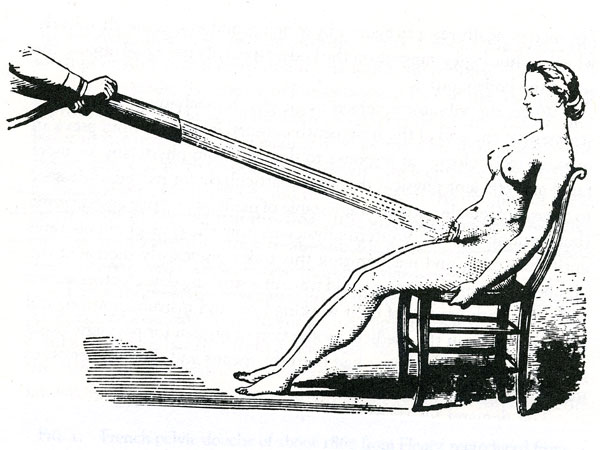
“Relax yourself, girl / Please settle down….”
I may have finally cleared up for you what Q-Tip was actually saying (he told me himself) on the chorus of A Tribe Called Quest’s hit 1993 single, whose title I’ve also lifted for today’s post. But that track’s hook also summarizes the sentiment which drove the development of a medical implement that, today, is a common sexual aid: The vibrator.
In the 19th century, doctors were commonly diagnosing “hysteria” in female patients, a condition marked, according to historian Rachel P. Maines, in her book, The Technology of Orgasm, as characterized by ”anxiety, sleeplessness, irritability,  nervousness, erotic fantasy, sensations of heaviness in the abdomen, lower pelvic edema and vaginal lubrication.” Hysteria was treated by inducing “paroxysm” in the patient, massaging her genitals until this state was reached. Manual methods, like the water massage technique, illustrated above, were applied. The development of early steam- or manually-powered vibrators, though, enabled doctors to stop using their hands and fingers for this task, while electric vibrators, such as this jackhammer-looking model, above right, made the process even more efficient.
nervousness, erotic fantasy, sensations of heaviness in the abdomen, lower pelvic edema and vaginal lubrication.” Hysteria was treated by inducing “paroxysm” in the patient, massaging her genitals until this state was reached. Manual methods, like the water massage technique, illustrated above, were applied. The development of early steam- or manually-powered vibrators, though, enabled doctors to stop using their hands and fingers for this task, while electric vibrators, such as this jackhammer-looking model, above right, made the process even more efficient.
If you’ve just read the previous paragraph in semi-disbelief, then said to yourself, “Hold up: In the 1800s, people were going to the doctor so he could get you off?”, you’re halfway there. Most people today would recognize “hysteria” as feminine sexual arousal. By categorizing it as an illness, however, Victorians avoided messy and uncomfortable discussions about the complexity of female sexuality and desire, relegating those discussions to the physician’s office, where they were, subsequently muted through categorization of the woman’s horniness as an illness. (There was no male equivalent of hysteria.) Argue producer/directors Wendy Slick and Emiko Omori, in their documentary PASSION & POWER: The Technology of Orgasm (a lot of title-borrowing today), hysteria “was a disease manufactured by doctors creating a lucrative clientele and a mutually camouflaged procedure that satisfied both” doctors and their patients.
Wendy Slick is a guest today on my WBAI-NY / 99.5 FM radio show, NONFICTION, this afternoon, Friday, March 20, at 2 pm ET.
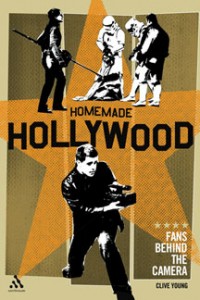 But first, we’ll also talk with author Clive Young, whose new book, Homemade Hollywood: Fans Behind The Camera, right, traces another history: That of the so-called “Fan Film revolution—an underground movement where backyard filmmakers are breaking the law to create unauthorized movies starring Batman, James Bond, Captain Kirk, Harry Potter and other classic characters,” ones “which copyrights and common sense would never allow.” I wrote about Star Wars fan films for the much-lamented PREMIERE magazine, back in 2001, so I’m looking forward to the conversation.
But first, we’ll also talk with author Clive Young, whose new book, Homemade Hollywood: Fans Behind The Camera, right, traces another history: That of the so-called “Fan Film revolution—an underground movement where backyard filmmakers are breaking the law to create unauthorized movies starring Batman, James Bond, Captain Kirk, Harry Potter and other classic characters,” ones “which copyrights and common sense would never allow.” I wrote about Star Wars fan films for the much-lamented PREMIERE magazine, back in 2001, so I’m looking forward to the conversation.
You can hear Wendy Slick’s and Clive Young’s ideas by tuning in at 2 pm. If you’re outside of the New York tri-state, check out our stream on the web. If you miss the live show, dig into our archives for up to 90 days after broadcast.
March 19th, 2009 — Advertising, Fashion, History, Media, Race

“Images of Black women that are in fact ‘national, racial, and historical hallucinations’ have been ingrained into the collective conscience of the United states since slavery. Black women have been depicted either naked, generally in an ethnographic context, or as laborers, usually domestic, their social status playing a crucial role in the development of visual identity. With rare exceptions, representations of the Black woman in art and photography have followed these prescribed lines.”—Kimberly Wallace-Sanders, Skin Deep, Spirit Strong: The Black Female Body in American Culture (Ann Arbor: University of Michigan Press, 2003), p. 182.
“I ‘members when they put me on the auction block. They pulled my dress down over my back to my waist, to show I ain’t gashed and slashed up. That’s to show you ain’t a mean nigger.”—Lu Perkins, quoted by James Mellon, ed., Bullwhip Days: The Slaves Remember: An Oral History (New York: Avon Books, 1988), p. 292.
In his 1985 book on the Atlanta child murders, The Evidence of Things Not Seen, writer James Baldwin (1924-1987) spoke of the “ancestral, daily, historical truth of Black life in this country,” then paused to note that, in the context of the African-American experience, the words “ancestral and daily are synonyms.” That is, they have the same meaning.
 What Baldwin, right, meant by that is what Black people state when they, speaking of the same conditions, inelegantly say, “Samo, samo.” In other words, same old thing, nothing’s different in any meaningful way. “You try and get ahead and they change the rules.” Whatever Black people do, white supremacy merely adapts. Or, as I often urge, “Why would they change what works?”
What Baldwin, right, meant by that is what Black people state when they, speaking of the same conditions, inelegantly say, “Samo, samo.” In other words, same old thing, nothing’s different in any meaningful way. “You try and get ahead and they change the rules.” Whatever Black people do, white supremacy merely adapts. Or, as I often urge, “Why would they change what works?”
It is utterly fascinating to see how frustrating these contentions remain to many white people. Their notion of history is heroic; a series of climaxes that they, like chiseled, blood-spattered action heroes, have wrangled. (Baldwin, right, of course, knew this, and in the aforementioned quote added that “historical does not refer to that spotless mirror in which the bulk of White North Americans imagine they see their faces,” but the actual, true history that Black people have borne.)
 Of course, when it comes to action-packed heroics, nothing tops this past November’s election and inauguration, right, of the current president. It was an achievement which moved many white people to quickly declare the age of Obama “post-racial.” A greater number said, more generously, but no less absurdly, that, in the wake of seating a Black president, “America had changed forever.” Pundit after pundit, in kind, asserted America’s “maturity” with this act.
Of course, when it comes to action-packed heroics, nothing tops this past November’s election and inauguration, right, of the current president. It was an achievement which moved many white people to quickly declare the age of Obama “post-racial.” A greater number said, more generously, but no less absurdly, that, in the wake of seating a Black president, “America had changed forever.” Pundit after pundit, in kind, asserted America’s “maturity” with this act.
Doesn’t having white people write their own absolution preserve white supremacy as a system? All of this, to me, had the quality of, after a home invasion and robbery, agreeing to let the thief fill out one’s insurance claim and police report. At the very least, one can agree that having the people who have victimized you quantify your mistreatment invokes a sizable conflict of interest.
Though all of the above is deeply relevant, none of this was on my mind Tuesday night, when, while watching American Idol, I saw an Old Navy commercial, titled “Mid-Town Flash,” below, in which a white actor, with one brisk move, strips off a Black female mannequin’s dress, leaving the figure, above, save for modesty bars, completely naked, smiling, and being curiously observed by her fellow mannequins, or “supermodelquins,” as the group are called in the corporation’s series of ads.
Continue reading →
March 18th, 2009 — Food, Politics, Race

Simply crazy about the 44th president? Don’t you wish you could just grab him and take him home with you? Well, now you can, and, when you get there, you can eat him, soaked in a delicious curry dip. (Thanks for the tip, Ray.) Says USA Today‘s “On Deadline” blog,
The German frozen food company Sprehe is offering a new product called “Obama Fingers,” which the packaging [above] describes as “tender, juicy pieces of chicken breast, coated and fried,” the German news magazine Der Spiegel reports.
The magazine quotes Judith Witting, a sales manager for the company, as saying Sprehe decided to offer the product after noting that “American products and the American way of eating are trendy at the moment.”
“Americans are more relaxed,” Witting explained. “Not like us stiff Germans, like (Chancellor Angela) Merkel.”
Possibly still doused with post-racial goodwill, however, there was no comment from “On Deadline” about something of which Der Spiegel seemed highly aware: Namely
a risk that the product might be seen as racially insensitive. Fried chicken has long been associated with African-Americans in the US — naming strips of fried chicken after the first black president could cause some furrowing of brows.
According to Der Spiegel, “The company says it was unaware of the possible racist overtones of the product.”
Witting told SPIEGEL ONLINE the connection never even occurred to her. “It was supposed to be a homage to the American lifestyle and the new US president,” she said.
Twenty bucks says Obama smiles it off.
[via On Deadline]






















 What Baldwin, right, meant by that is what Black people state when they, speaking of the same conditions, inelegantly say, “Samo, samo.” In other words, same old thing, nothing’s different in any meaningful way. “You try and get ahead and they change the rules.” Whatever Black people do, white supremacy merely adapts. Or, as I often urge, “Why would they change what works?”
What Baldwin, right, meant by that is what Black people state when they, speaking of the same conditions, inelegantly say, “Samo, samo.” In other words, same old thing, nothing’s different in any meaningful way. “You try and get ahead and they change the rules.” Whatever Black people do, white supremacy merely adapts. Or, as I often urge, “Why would they change what works?” Of course, when it comes to action-packed heroics, nothing tops this past November’s election and inauguration, right, of the current president. It was an achievement which moved many white people to quickly declare the age of Obama “post-racial.” A greater number said, more generously, but no less absurdly, that, in the wake of seating a Black president, “America had changed forever.” Pundit after pundit, in kind, asserted America’s “maturity” with this act.
Of course, when it comes to action-packed heroics, nothing tops this past November’s election and inauguration, right, of the current president. It was an achievement which moved many white people to quickly declare the age of Obama “post-racial.” A greater number said, more generously, but no less absurdly, that, in the wake of seating a Black president, “America had changed forever.” Pundit after pundit, in kind, asserted America’s “maturity” with this act.
